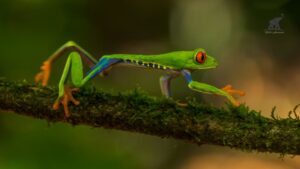Ladybugs are often seen as charming little visitors in our gardens, but have you ever wondered what eats ladybugs? It’s a fascinating question, as these seemingly defenseless beetles have a surprising number of survival tricks up their sleeves. While they are a welcome sign of a healthy ecosystem, they aren’t entirely safe from predators.
Despite their cheerful appearance, the life of a ladybug isn’t always a peaceful one. They must constantly be on the lookout for threats. Understanding what eats ladybugs gives us a deeper appreciation for their role in the food web and the incredible ways they’ve adapted to survive. This article explores the predators that manage to overcome their defenses.
Ladybug Predators at a Glance
Before we dive deep, here’s a quick summary of the primary creatures that prey on these colorful insects.
| Predator | Type | Why They Eat Ladybugs |
| Birds | Avian | Some species can tolerate or bypass the ladybug’s toxins. |
| Spiders | Arachnid | Ambush predators that trap ladybugs in webs or catch them off guard. |
| Assassin Bugs | Insect | Pierce ladybugs with their mouthparts and consume their insides. |
| Frogs & Toads | Amphibian | Opportunistic eaters that may consume ladybugs that cross their path. |
| Dragonflies | Insect | Agile aerial hunters that can catch ladybugs mid-flight. |
| Praying Mantises | Insect | Patient predators that ambush unsuspecting ladybugs. |
The Surprising Truth About Ladybug Predators
You might think that a ladybug’s bright red and black coloring would make it an easy target. However, that couldn’t be further from the truth. This vibrant coloration is a form of “aposematism,” a warning sign to potential predators that says, “I taste terrible, and I might be poisonous!”

This warning is not a bluff. When threatened, ladybugs release a foul-smelling, yellow fluid from their leg joints. This phenomenon, known as “reflex bleeding,” is a powerful deterrent. The fluid is laced with alkaloids, making them bitter and often toxic to many would-be attackers.
Because of this brilliant defense mechanism, many animals learn to avoid them. A young, inexperienced bird might try to eat a ladybug once, but the disgusting experience is usually enough to ensure it never makes the same mistake again. This is why when you ask, “what eats ladybugs?” the answer isn’t as long as you might expect.
The Bold Few: Who Actually Eats Ladybugs?
Despite their formidable defenses, some predators have adapted, learned, or are simply desperate enough to make a meal out of a ladybug. The question of what eats ladybugs reveals a list of resilient and specialized hunters.

Avian Adversaries: Birds
While most birds steer clear of ladybugs, some species are known to consume them, especially during times when other food sources are scarce.
Swallows and Martins
These agile birds are aerial insectivores, meaning they catch insects on the wing. Swallows and purple martins have been observed eating ladybugs, particularly during large ladybug swarms. Their strategy often involves catching the beetles so quickly that the ladybugs don’t have time to release their defensive chemicals.
Starlings
Starlings are known for being unfussy eaters. Their opportunistic nature means they will consume ladybugs if they are readily available, though they don’t seem to seek them out specifically. They appear less sensitive to the ladybugs’ bitter taste compared to other birds. This makes them a key answer to the question of what eats ladybugs in the avian world.
The Insect and Arachnid Onslaught
Some of the most significant threats to ladybugs come from their own kind: other insects and arachnids. These predators are often small enough to be unaffected by the toxins or have specialized ways of overcoming them.
Assassin Bugs
The name says it all. Assassin bugs are fearsome predators in the insect world. They use their sharp, piercing mouthpart, called a rostrum, to stab their prey and inject a paralyzing, tissue-dissolving saliva. They then suck out the liquefied insides, completely bypassing the ladybug’s bad-tasting exterior and reflex bleeding. For these bugs, the ladybug’s defenses are utterly useless, making them a top predator when considering what eats ladybugs.
Spiders
Spiders are patient, opportunistic hunters. Many don’t actively hunt ladybugs but will happily consume one that gets tangled in their web. Orb-weavers and cobweb spiders simply wrap the struggling ladybug in silk, immobilizing it before it can mount a defense. Jumping spiders, with their excellent vision and pounce-attack, can also ambush a ladybug before it knows what’s happening.
Praying Mantises
Another formidable ambush predator, the praying mantis, will eat almost any insect it can catch, including ladybugs. Their powerful, spiky forelegs can snatch a ladybug in an instant. Like the assassin bug, their method of consumption can sometimes bypass the worst of the ladybug’s chemical defenses. What eats ladybugs? A hungry mantis certainly does.
Dragonflies
As masters of the sky, dragonflies can outmaneuver and snatch ladybugs right out of the air. Their incredible speed and agility make them a serious threat, especially to ladybugs in flight.
Amphibians and Reptiles: The Opportunistic Eaters
Frogs, toads, and some lizards are generally not picky. They tend to have a simple rule: if it moves and fits in their mouth, it’s food.
An anole lizard or a tree frog might snap up a ladybug that wanders by without a second thought. While they may find the taste unpleasant, their method of swallowing prey whole can mitigate the effects of the ladybug’s defenses. These creatures are an important part of the answer to what eats ladybugs, even if it’s not their favorite meal.
The Hidden Threat: Parasitoids
Perhaps the most gruesome fate for a ladybug comes from a tiny parasitic wasp called Dinocampus coccinellae. This wasp doesn’t eat the adult ladybug directly. Instead, it injects a single egg into the ladybug’s abdomen.
The wasp larva hatches inside the ladybug and begins to eat its internal tissues, carefully avoiding vital organs to keep its host alive. After a few weeks, the larva emerges from the ladybug and spins a cocoon between its legs.
In a zombie-like state, the partially paralyzed ladybug stands guard over the cocoon, twitching violently to ward off any potential predators. This bodyguard duty is the ladybug’s final, tragic act. The wasp’s lifecycle is a chilling and highly specific answer to the question of what eats ladybugs from the inside out.
Do Ladybugs Eat Each Other?
Yes, they do! Ladybug cannibalism is surprisingly common, especially in the larval stage. If a ladybug larva hatches before its siblings, it will often turn and eat the unhatched eggs.
Adult ladybugs will also eat larvae and pupae if their primary food source, aphids, is scarce. It’s a brutal survival strategy, but it ensures that the strongest individuals survive to reproduce. This internal competition is a crucial factor to consider when thinking about what eats ladybugs.
How Do Ladybugs Defend Themselves?
We’ve touched on their defenses, but it’s worth summarizing the amazing ways these little beetles protect themselves.
- Warning Colors (Aposematism): Their bright red, orange, or yellow colors signal “danger” to predators.
- Reflex Bleeding: They secrete a foul-tasting, toxic yellow fluid from their legs.
- Playing Dead: When startled, a ladybug will often pull its legs and antennae in and drop to the ground, hoping the threat passes it by.
- Hiding: They are experts at finding crevices in bark, leaves, and homes to hide from both predators and bad weather.
These defenses are highly effective, which is why the list of what eats ladybugs is relatively short. They are a testament to how even a small creature can evolve powerful ways to survive.
The Impact of Invasive Ladybugs
Not all ladybugs are the same. The multicolored Asian lady beetle (Harmonia axyridis) is an invasive species in North America and Europe. They are more aggressive and have even stronger chemical defenses than many native species.
This gives them a competitive edge. They outcompete native ladybugs for food and are even known to eat native ladybug eggs and larvae. Furthermore, their particularly noxious defenses make them even less appealing to local predators. So, when asking what eats ladybugs, the answer might be different for this invasive type, as fewer local predators can stomach them.
Conclusion
The question of “what eats ladybugs?” opens up a fascinating window into the complexities of the food web. While their bright colors and potent chemical defenses protect them from most threats, a specialized group of predators has learned to overcome these protections. From stealthy assassin bugs and agile dragonflies to opportunistic birds and frogs, the ladybug must navigate a world filled with danger.
Even more surprisingly, some of the biggest threats come from within their own species and from terrifying parasitoids. The ladybug’s life is a constant balance of finding food and avoiding becoming food itself. So, the next time you see one of these charming beetles in your garden, you can appreciate the incredible story of survival it represents.
Frequently Asked Questions (FAQs)
1. Do birds really eat ladybugs?
Yes, some birds do, but not many. Swallows, martins, and starlings are the most common avian predators of ladybugs. Most birds learn to avoid them due to their bitter taste and toxic secretions.
2. Are ladybugs poisonous to dogs or cats?
While not fatally poisonous, if a dog or cat eats a large number of ladybugs (especially the invasive Asian lady beetle), the alkaloids can cause irritation to their mouth and digestive tract, leading to drooling and vomiting. It’s best to discourage your pets from eating them.
3. What is the main predator of a ladybug?
It’s hard to name just one, but insects like assassin bugs and praying mantises, as well as parasitic wasps, are among their most effective and specialized predators. They have methods to bypass the ladybug’s primary chemical defenses.
4. Why do ladybugs come into my house?
Ladybugs, particularly the Asian lady beetle, seek warm, sheltered places to hibernate during the winter. Your house provides the perfect refuge from the cold, which is why you might see them gathering on sunny walls or near windows in the fall.
5. Do spiders eat ladybugs?
Yes, spiders are a common predator. They don’t typically hunt ladybugs specifically, but a ladybug that accidentally wanders into a spider’s web is likely to become a meal. The spider’s silk immobilizes the ladybug, preventing it from using its defenses.












